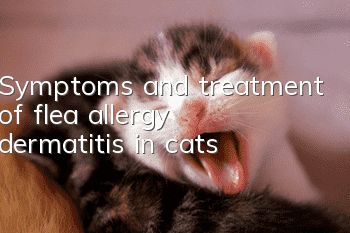Symptoms and treatment of flea allergy dermatitis in cats

Do you think your cat must have a very serious skin disease due to extensive hair loss, facial erosion, and eosinophilic plaque erosion on its limbs? However, can you imagine that this is caused by tiny fleas? If the cat is infected Fleas, then 8% of cats will be allergic to flea bites. That is, if 100 cats have fleas, 8 cats will be allergic. This also means that flea allergy dermatitis is very common. . So today, let’s talk about allergic dermatitis caused by fleas.
Why do fleas cause cat allergies
Flea saliva contains a variety of histamine compounds, enzymes, peptides, and amino acids of 40~60kD. Then when a flea bites a cat, these substances will be injected into the cat's body, causing type I, type IV and alkaline granulocytic allergic reactions. To put it simply, some cats are allergic to flea saliva proteins
Flea allergy dermatitis symptoms
So what are the symptoms of flea allergy dermatitis? Cats usually have the following symptoms:
Pruritic miliary dermatitis, accompanied by secondary scratches and scabs. Miliary dermatitis is prone to occur on cats' backs, necks and faces. They are small rashes that are very itchy and the cat will lick and scratch them over and over again.
Hair loss will occur on the neck, waist, back, inner thighs and lower abdomen. Allergic hair removal on the abdomen, without obvious skin inflammation, is often mistaken for mental hair removal
Symptoms and treatment of flea allergy dermatitis in cats
Symmetrical hair loss secondary to excessive grooming.
Eosinophilic granulomatosis syndrome may also occur: that is, allergic cats will have a very typical dermatitis characterized by severe itching.
We will see cats being restless, scratching, scratching, licking, or even biting their skin for a long time. Common secondary symptoms include hair loss, erythema, papule-like skin and scaly skin, and the formation of scabs after shedding, etc. Some extremely sensitive cats will have obvious excessive head hair loss, erythema and self-mutilation, and the trauma will further cause exudative dermatitis.
Then, some poop collectors may ask, if a cat is bitten by a flea, it will itch. How to judge whether it is allergic?
Very simple:
Animals with non-allergic reactions may not have obvious symptoms and may suffer from occasional scratches due to flea bites. However, allergic animals will suffer from dermatitis that is typically characterized by severe itching of the skin, focusing on severe itching and dermatitis.
Note: Not every cat suffering from flea allergy dermatitis will have severe symptoms. The difference in clinical symptoms mainly depends on the frequency of contact with fleas and the disease.course, secondary skin infections or complications, severity of allergies, previous or current treatments, etc.
How to diagnose flea allergy dermatitis in cats?
So how to judge whether a cat has flea allergy dermatitis? After all, there are so many causes of similar symptoms, yes, flea allergy dermatitis and atopic dermatitis, food allergy, other external parasites (scabies, scabies, Cheliced mites, pediculosis, demodicosis), superficial pyoderma, dermatophytosis, Malassezia dermatitis, etc. are all quite similar. But that doesn’t mean it can’t be identified:
If we find fleas and flea feces on the cat, we must first highly suspect flea dermatitis. The small black spots are the excrement of fleas after sucking blood and digesting it.
Symptoms and treatment of flea allergy dermatitis in cats
Then you can conduct allergic reaction tests on cats: intradermal tests and serological tests. A positive flea antigen skin test or a positive serum immunoglobulin IgE anti-flea antibody titer is highly suggestive of flea dermatitis in your cat.
Finally, you can also work backwards and treat the cat’s fleas directly. When there are no more fleas on the cat and the symptoms have improved or disappeared, it means that the cat has suffered from flea allergy dermatitis before.
How to treat flea allergy dermatitis in cats?
To treat flea allergy dermatitis, the most important and most effective way is to eliminate the source of the allergy: fleas
Symptoms and treatment of flea allergy dermatitis in cats
External sprays or drops: I don’t recommend the brand anymore. If you search for cat flea spray or cat flea drops on Taobao, you will see a lot of them. Note: If the kitten is less than 6 weeks old, it is best to use an external spray to kill fleas.
Insecticide bath: Some shower gels contain insecticidal ingredients, which can effectively kill adult insects on cats, but have little effect on eggs. However, no matter which insecticide method is used, it may not be possible in one go. Completely eliminate all fleas, because only about 5% of fleas on cats are present, and the remaining 95% are lurking in the environment, and fleas will lay an astonishing number of eggs every day.
Symptoms and treatment of flea allergy dermatitis in cats
Therefore, disinfection in the environment is also very important, including thorough cleaning, spraying insecticides, cleaning, and disinfection. Moreover, because fleas cannot be completely killed at one time, it also means that cats’ allergic dermatitis cannot be completely cured at once, so auxiliary treatment is very necessary.
Adjuvant therapy is usually the use of corticosteroids to control pruritus and secondary dermatoses in allergic animals. in addition, if the cat has secondary bacterial skin infection, it needs to be treated with corresponding sensitive antibiotics. In short, the treatment idea for flea allergy dermatitis in cats is: treatment of the cause + symptomatic treatment. That is, deworming, controlling itching in cats, and treating secondary skin diseases.
Finally, the best way is to take precautions before they happen! Be sure to deworm regularly!
- Taboo foods for cats
- What should I do if my cat is afraid of the vacuum cleaner? The cat will collapse as soon as it encounters the vacuum cleaner!
- Reasons why cats love to pounce on people
- What is better for Turkish Angora cats to eat?
- How to clean a cat climbing frame? (How to clean the cat climbing frame?)
- Does a cat’s snoring mean it’s comfortable?
- What to do if there is static electricity on a cat? How to eliminate static electricity?
- What should a one month old kitten eat?
- Can a three-month-old Persian cat take a bath? What should you pay attention to when taking a bath?
- Will male cats get infected if they undergo neutering surgery in summer?



